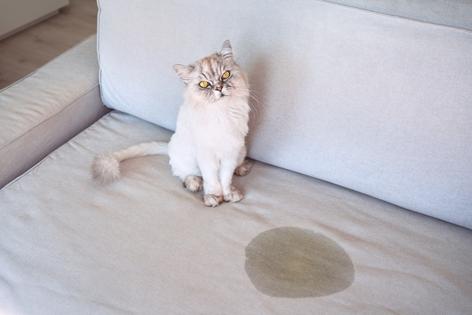My Pet World: Some cats pee on couches; other cats get dive-bombed by birds
Dear Cathy,
We recently noticed our rescue cat Chanel has been urinating on our couches. I tried putting ammonia on the spots after washing them and rubbing her nose on the sites. Nothing helps. She keeps doing it. We adopted Chanel and CoCo from the same cage at the same shelter. We are afraid CoCo will follow Chanel and do the same thing. How do we stop Chanel from doing this?
– Angie, Henderson Nevada
Dear Angie,
Many things can trigger improper elimination with cats, from litter box placement, type of litter, and cleanliness to anxiety, stress, or simply seeing another cat outside. Until you know, you will have to try several things to see what works.
To begin, take Chanel to your veterinarian for an exam. When animals suddenly begin urinating on furniture and other odd places, it can signify a health problem or illness. Once treated, these improper eliminations should stop. Rule that out quickly so you know what to try next.
Next, don’t use ammonia to clean her accidents. Ammonia is a natural by-product of urine, designed to attract cats back to the exact location or tell another cat to stay away. When you clean with ammonia, you are inviting Chanel (and potentially CoCo) to pee on the couch. (I bet you’re freaking out a little that you did this. Don’t, it’s a common mistake.)
To keep both cats from urinating on the couch, use an enzymatic cleaner, which eats up the biologicals left in the furniture (urine, fecal matter, and feces), removing all traces of the waste and odor.
Afterward, you could also try to spray the area with Bitter Apple (available at the pet store) to discourage them or put up a roadblock directly over the spot, like a box to encourage them to use the spot for napping instead. (Don’t rub your cat’s nose in the urine. I am not sure why pet owners so widely do this, but it doesn’t work and is not a legitimate training technique. In fact, it could have the opposite effect.)
Keep the same number of boxes as cats plus one – so three boxes. Leave the lid off one of the litter boxes in case Chanel prefers to stand on the edge to relieve herself. Place the litter boxes in different areas since one resident cat can block another resident cat from using a particular box. (The cat could not protect all three litter boxes if they are in different areas of the house.) Sift the litter twice daily and use a litter box attractant (available at pet stores) in all three boxes to help lure Chanel back to the box.
...continued
(c) 2022 DISTRIBUTED BY TRIBUNE MEDIA SERVICES, INC.










